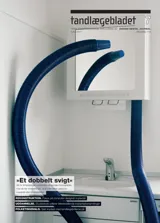10-års klinisk og radiologisk evaluering af enkelttandsimplantater udført af tandlægestuderende
Formål – At evaluere behandlingsresultatet af enkelttandsimplantater udført af tandlægestuderende som en del af deres kandidatuddannelse. Materiale og metode – I alt 51 konsekutive patienter blev af tandlægestuderende behandlet med 55 enkelttandsimplantater. Behandlingen blev udført under supervision af tandlæger og specialtandlæger i TMK-kirurgi, alle med særlig viden om oral implantologi. Overlevelsen af implantatkronen, overlevelsen af implantatet, pochedybde, blødning ved pochemåling og periimplantært marginalt knogletab blev evalueret efter 10 år. Derudover blev biologiske og tekniske komplikationer i den 10-årige opfølgningsperiode registreret. Resultater – I alt var 45 patienter med 49 implantater tilgængelige for 10-års kontrol. Overlevelsen af både implantatkroner og implantater var 94 %. Den gennemsnitlige pochedybde på patientniveau var 4,8 mm. Pochedybden varierede mellem 2 og 10 mm på det enkelte målested. Den gennemsnitlige score for blødning ved pochemåling var 0,57 på patientniveau, og fravær af blødningen ved alle flader af et implantat blev sjældent observeret. Det gennemsnitlige marginale knogletab et år efter montering af kronen var 0,14 mm (variationsbredde: –1,2 til 1,1 mm) på patientniveau. Det marginale knogleniveau var stabilt efter et år. Der blev registreret fem tilfælde af periimplantær inflammation, som blev tilskrevet cementoverskud. Endelig var der fem tekniske komplikationer i fem patienter. Konklusion – Enkelttandsimplantater udført af tandlægestuderende som en del af deres kandidatuddannelse var kendetegnet ved høj overlevelse af såvel implantat som krone samt få biologiske og tekniske komplikationer. Det synes derfor acceptabelt at udføre implantatbehandling som en del af tandlægeuddannelsen, forudsat at der udvælges ukomplicerede patienttilfælde, og at behandlingen udføres under supervision af velkvalificerede kliniske lærere.
Outcome of implant-supported single tooth replacements performed by dental students.
A 10-year clinical and radiographic retrospective study Aim – To evaluate the treatment outcome of implant-supported single tooth replacements performed by dental students as part of their undergraduate dental curriculum. Materials and methods – A total of 51 patients were treated by dental students with 55 implants supporting single crowns. The treatment was performed under supervision of dentists and oral and maxillofacial surgeons all with special knowledge about oral implantology. Survival of the implant crown, the survival of implant, the probing depth, the bleeding on probing, and the peri-implant marginal bone loss were evaluated after 10 years. In addition, biological and technical complications during the 10-year follow-up period were assessed. Results – A total of 45 patients with 49 implants were available for the 10-year follow-up. The survival of the implant crowns as well as the implants was 94 %. The mean probing depth at patient level was 4.8 mm. The probing depth varied between 2 and 10 mm at the individual site. The mean bleeding on probing score was 0.57 at patient level and absence of bleeding around all sites of the implants was rarely observed. The mean bone loss during the first year of loading was 0.14 (Range: –1.2 to 1.1) mm at patient level. The marginal bone level was stable after 1 year. Five episodes of peri-implant inflammation due to excess cement were registered. Finally, few technical complications were identified. Conclusions – Implant-supported single tooth replacements performed by dental students as part of their undergraduate dental curriculum were characterized by high survival of implant crowns and implants as well as few biological and technical complications. It seems acceptable to include implant therapy in the clinical undergraduate dental curriculum provided focus on straightforward cases and substantial supervision by trained dentists and oral and maxillofacial surgeons.


